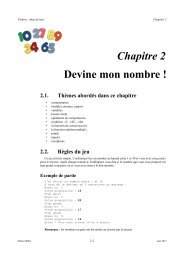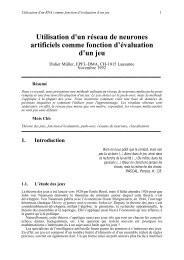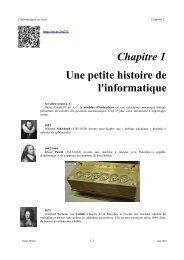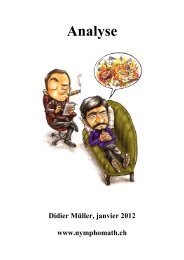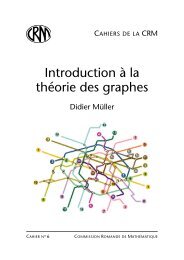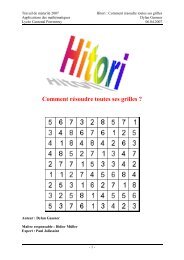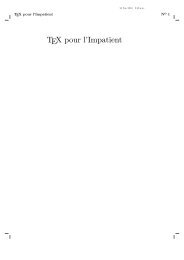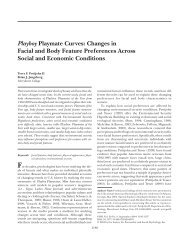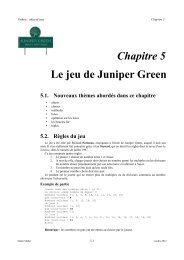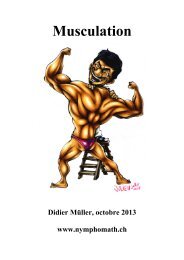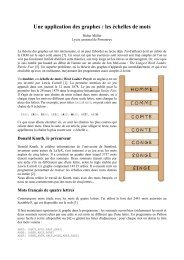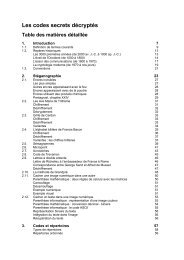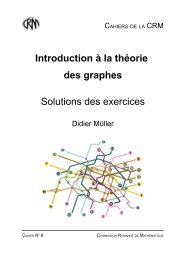William F. Friedman's Transcription of the Voynich Manuscript
William F. Friedman's Transcription of the Voynich Manuscript
William F. Friedman's Transcription of the Voynich Manuscript
Create successful ePaper yourself
Turn your PDF publications into a flip-book with our unique Google optimized e-Paper software.
<strong>William</strong> F. Friedman’s <strong>Transcription</strong> <strong>of</strong> <strong>the</strong> <strong>Voynich</strong> <strong>Manuscript</strong>Jim ReedsAT&T Bell LaboratoriesMurray Hill, New Jersey 07974ABSTRACTThe <strong>Voynich</strong> <strong>Manuscript</strong> is a late medieval or early modern book written inan unknown cipher alphabet. It has resisted <strong>the</strong> efforts <strong>of</strong> several <strong>of</strong> <strong>the</strong> century’sbest cryptanalysts to break its cipher. One <strong>of</strong> <strong>the</strong>m, <strong>William</strong> F. Friedman, prepareda machine readable transcription <strong>of</strong> this book half a century ago; this transcriptionhas recently been unear<strong>the</strong>d from <strong>the</strong> archives and placed on line.IntroductionFor <strong>the</strong> better part <strong>of</strong> this century scholars have been puzzled by <strong>the</strong> mysterious, stillunread,<strong>Voynich</strong> cipher manuscript.* Notable among <strong>the</strong>se was <strong>the</strong> eminent American cryptologist<strong>William</strong> F. Friedman, who organized an effort to transcribe and decipher <strong>the</strong> VMS at <strong>the</strong> end<strong>of</strong> World War II.One <strong>of</strong> <strong>the</strong> difficulties facing anyone attempting to read <strong>the</strong> <strong>Voynich</strong> manuscript is <strong>the</strong>tedium <strong>of</strong> preparing a transcription into conventional alphabetic or numerical symbols, in order tomake possible frequency counts and concordances. Such a transcription requires study <strong>of</strong> <strong>of</strong>tenunclear photocopies, and, if carried out with conscientious regard for accuracy, is very time________________*Hereafter abbreviated ‘‘VMS.’’7 September 1994
- 2 -consuming. My experience suggests that after transcribing about ten pages <strong>the</strong> would-be VMSreader loses interest in <strong>the</strong> task, starts worrying about his eyesight and stops work, leaving morethan two hundred pages untranscribed.It was with great pleasure, <strong>the</strong>n, that I discovered in <strong>the</strong> <strong>William</strong> F. Friedman Collection† <strong>of</strong><strong>the</strong> George C. Marshall Foundation a transcription made half a century ago <strong>of</strong> almost all <strong>of</strong> <strong>the</strong><strong>Voynich</strong> manuscript. This transcription, item 1609 in <strong>the</strong> Friedman Collection, is a printout <strong>of</strong> anIBM card ‘‘edition’’ <strong>of</strong> <strong>the</strong> VMS. It is <strong>the</strong> product <strong>of</strong> what M. E. D’Imperio [D1] calls <strong>the</strong> ‘‘First<strong>Voynich</strong> <strong>Manuscript</strong> Study Group’’ <strong>of</strong> 1944-46 (here abbreviated FSG), which was an un<strong>of</strong>ficialafter-hours club <strong>of</strong> U. S. Army cryptanalysts at <strong>the</strong> end <strong>of</strong> World War II. As far as I know, it is<strong>the</strong> only complete transcription <strong>of</strong> <strong>the</strong> whole VMS into conventional symbols, yet its existencehas not been mentioned in print until now; D’Imperio [D1] seems unaware <strong>of</strong> its existence. Itmay well be <strong>the</strong> first example <strong>of</strong> a machine readable edition <strong>of</strong> a text prepared for scholarly purposes.This paper describes item 1609 and places it in <strong>the</strong> context <strong>of</strong> <strong>the</strong> activities <strong>of</strong> <strong>the</strong> 1944-46study group and in <strong>the</strong> context <strong>of</strong> Mr. and Mrs. Friedman’s longstanding interest in <strong>the</strong> <strong>Voynich</strong>manuscript, as revealed in <strong>the</strong> holdings <strong>of</strong> <strong>the</strong> Friedman Collection.The present paper should be regarded as a contribution to <strong>the</strong> historiography — but not to<strong>the</strong> solution — <strong>of</strong> <strong>the</strong> <strong>Voynich</strong> manuscript. In a later paper I hope to present a statistical analysis<strong>of</strong> <strong>the</strong> VMS text itself, based on Friedman’s transcription.The <strong>Voynich</strong> <strong>Manuscript</strong>The following facts about <strong>the</strong> VMS are repeated in almost everything written on <strong>the</strong> subject.The VMS is a book <strong>of</strong> about 104 vellum leaves, sized about 16 cm by 23 cm (6 by 9 inches),written in an unknown (but apparently alphabetical) script. It is pr<strong>of</strong>usely illustrated with plantdrawings, zodiacal diagrams, what have been called ‘‘cosmological’’ diagrams, and diagrams________________†No general survey <strong>of</strong> <strong>the</strong> contents <strong>of</strong> this collection has been published. The items mentioned in this paperaccount for perhaps three quarters <strong>of</strong> <strong>the</strong> <strong>Voynich</strong> material in <strong>the</strong> collection; at a later time I hope to publish asystematic survey <strong>of</strong> <strong>the</strong> <strong>Voynich</strong> holdings.7 September 1994
- 3 -with unclo<strong>the</strong>d women romping on what seem to be water slides. The style <strong>of</strong> writing and <strong>of</strong>drawing seem to place its production in <strong>the</strong> late 1400s or early 1500s, possibly in central Europe.The VMS was found in Italy in 1912 by <strong>the</strong> American rare book dealer Wilfrid <strong>Voynich</strong> [V,1921]. A letter found with <strong>the</strong> manuscript, a faded signature on <strong>the</strong> first page, and a variety <strong>of</strong>collateral or circumstantial evidence definitely place <strong>the</strong> book at <strong>the</strong> Prague court <strong>of</strong> Rudolph II,Holy Roman Emperor from 1576 to 1611, and probably place it in <strong>the</strong> possession <strong>of</strong> <strong>the</strong> Englishma<strong>the</strong>matician and astrologer, John Dee, who was at Rudolph’s court at various times between1584 and 1588.Ownership passed through <strong>Voynich</strong>’s heirs to H. P. Krauss, ano<strong>the</strong>r rare book dealer, whogave it to Yale University, where it is now MS 408 in <strong>the</strong> Beinecke Rare Book Library.Since its discovery in modern times <strong>the</strong> problem <strong>of</strong> reading this book (or indeed, <strong>of</strong> makingany sense out <strong>of</strong> it at all) has been a tantalizing puzzle to many scholars. About ten solutionshave been <strong>of</strong>fered in print, <strong>of</strong> varying degrees <strong>of</strong> implausibility. The claimed authors and topicsinclude: God, Roger Bacon, Anthony Askham, Cathars, Khazars, spiral nebulae, contraceptives,suicide, capsicum, sunflowers and o<strong>the</strong>r botanical novelties from <strong>the</strong> New World. <strong>William</strong> R.Newbold’s 1928 book The Cipher <strong>of</strong> Roger Bacon [N] contains <strong>the</strong> oldest and most notorioussuch fallacious solution, which was refuted by J. M. Manly [M]. There is a largely repetitioussecondary literature on <strong>the</strong> VMS, a sampling <strong>of</strong> which is listed in <strong>the</strong> bibliography.There are two serious books. Brumbaugh [Br] <strong>of</strong>fers — with unconvincing evidence — <strong>the</strong>attractive <strong>the</strong>ory that <strong>the</strong> book has no meaning, but was concocted as a hoax: a neo-Platonist rarityto sell to a wealthy gull, most likely <strong>the</strong> Emperor. In contrast, D’Imperio’s book [D1] — anencyclopedic survey <strong>of</strong> everything known or conjectured (up to 1978) about <strong>the</strong> VMS — <strong>of</strong>fersno solution <strong>of</strong> its own. Because D’Imperio was able to interview many <strong>of</strong> Friedman’s <strong>Voynich</strong>collaborators (especially John Tiltman and Prescott Currier), her book is most useful as a guide to<strong>the</strong> Friedman collection; <strong>the</strong> preface by John Tiltman makes clear a form <strong>of</strong> ‘‘apostolic succession’’:D’Imperio succeeds Tiltman, who succeeded Friedman as ‘‘un<strong>of</strong>ficial coordinator <strong>of</strong> <strong>the</strong>work <strong>of</strong> some <strong>of</strong> <strong>the</strong> people who have been working on <strong>the</strong> problem.’’A privately printed pamphlet seminar proceedings by D’Imperio [D2] contains <strong>the</strong> best7 September 1994
- 4 -statistical data about <strong>the</strong> VMS. The most accessible general account is perhaps in Kahn [K],pp.863-872. Clear reproductions <strong>of</strong> a few VMS pages may be found in [K], [N], [T], and [Z], butnot in [Br] or [D1].W. F. Friedman and <strong>the</strong> VMSElizebeth S. and <strong>William</strong> F. Friedman’s longstanding interest in <strong>the</strong> <strong>Voynich</strong> manuscript iswell reflected in <strong>the</strong> holdings <strong>of</strong> <strong>the</strong> Friedman collection in <strong>the</strong> Marshall Library in Lexington,Virginia.They became interested in <strong>the</strong> VMS as soon as Newbold began publicizing his <strong>the</strong>oriesabout <strong>the</strong> VMS in <strong>the</strong> 1920s, and started an extensive correspondence on <strong>the</strong> subject with <strong>the</strong>irfriend John M. Manly, <strong>the</strong> University <strong>of</strong> Chicago Chaucer expert who, like Friedman, had servedas a cryptanalyst in World War I. Friedman obtained photostats from Mrs. <strong>Voynich</strong>, and throughher, started a correspondence with Fa<strong>the</strong>r Theodore C. Petersen which lasted until <strong>the</strong> latter’sdeath in 1966. Petersen’s hand-made tracing onto onion-skin paper is now item 1620 in <strong>the</strong> collection,and is amply described on page 41 <strong>of</strong> D’Imperio’s book. After making <strong>the</strong> copy, Petersenprepared elaborate indexes and frequency counts (both into notebooks and onto index cards — allnow in <strong>the</strong> Friedman collection — but in <strong>the</strong> process scribbled up his copy with underlinings, coloredpencil marks, and so on, to <strong>the</strong> extent that photocopies <strong>of</strong> his copy are <strong>of</strong>ten hard to makeout.Friedman’s extensive VMS photostat collection is based in part on Petersen’s, but it is nowimpossible to give a precise acquisition date or provenance for each photostat. Some wereobtained from Mrs. <strong>Voynich</strong>, some were copied from Petersen’s copy <strong>of</strong> photostats, some werecopied from published images <strong>of</strong> VMS pages.A bound set <strong>of</strong> photostats, item 1600 in <strong>the</strong> collection, was ei<strong>the</strong>r made for Fa<strong>the</strong>r Petersenin 1931, or is a copy <strong>of</strong> that set. (See D’Imperio, pp. 39 and 41 for slightly conflicting accounts;Tiltman [T, p.44] asserts that Friedman’s photostats were copied from Petersen’s, and Tiltman’sfrom Friedman’s.) It consists <strong>of</strong> 125 sheets <strong>of</strong> photographs, printed on large sheets <strong>of</strong> stiff photographicpaper <strong>of</strong> varying sizes. One or two pages <strong>of</strong> <strong>the</strong> VMS is shown on each sheet, each page7 September 1994
- 5 -marked with a small penciled, circled, page number. On most <strong>of</strong> <strong>the</strong> photostats a patch <strong>of</strong> black isvisible, on which a folio number has been written in white ink*, in yet a different handwriting;possibly <strong>Voynich</strong>’s. The first photostat in <strong>the</strong> bundle is a negative reproduction <strong>of</strong> Newbold’sPlate XXI, with Friedman’s handwritten note ‘‘Note: This is a page which I have added as a protectionto f1 <strong>of</strong> <strong>the</strong> original. Taken from <strong>the</strong> Newbold-Kent book on <strong>the</strong> <strong>Voynich</strong> MSS. W.F.F.’’The next photostat shows <strong>the</strong> first page <strong>of</strong> <strong>the</strong> VMS, has a circled ‘‘1’’ and <strong>the</strong> white ink labelreads ‘‘Fol. 1 recto,’’ and so on. The photostats D’Imperio herself used, described on page 40 <strong>of</strong>her book, defaced bycopious and obtrusive remains <strong>of</strong> at least one previous computer processing project,including circled words and paragraphs, lines marking <strong>of</strong>f parts <strong>of</strong> <strong>the</strong> text, and legendssuch as ‘‘start here,’’ ‘‘omit punch,’’ and ‘‘punch just this’’were apparently derived from <strong>the</strong> set in <strong>the</strong> Friedman collection, which are not as severelydefaced, but which do have such legends as ‘‘omit punch (entire page)’’ on photostat page 112(showing f.57v), a ‘‘punch just this’’ on photostat page 119 (f.67r), etc. She might have beenusing Tiltman’s set [T, p.44].Towards <strong>the</strong> end <strong>of</strong> World War II Friedman’s <strong>Voynich</strong> investigations took a more seriousturn, with <strong>the</strong> formation <strong>of</strong> what D’Imperio called <strong>the</strong> ‘‘First <strong>Voynich</strong> <strong>Manuscript</strong> Study Group,’’(FSG) an after-hours informal club <strong>of</strong> Army cryptanalysts. This club was apparently activebetween 1944 and 1946; <strong>the</strong> results <strong>of</strong> its activity are described below. In 1946 Friedmanobtained a report (in folder 1614) on <strong>the</strong> VMS’s handwriting from his colleague Albert HowardCarter (later pr<strong>of</strong>essor <strong>of</strong> literature at Eckerd College).In 1951 Friedman was able to interest John Tiltman, a British cryptanalyst he hadbefriended during <strong>the</strong> war, in <strong>the</strong> VMS. It seems that Tiltman became Friedman’s closest confidant,at least in <strong>Voynich</strong>ological matters. In <strong>the</strong> early 1950s Friedman developed his <strong>the</strong>ory that________________*Many <strong>of</strong> <strong>the</strong> VMS leaves are foldouts, and <strong>the</strong> existing folio numbers do not all lie on <strong>the</strong> recto sides <strong>of</strong> <strong>the</strong>leaves. Hence it is not always obvious what to call any given page <strong>of</strong> <strong>the</strong> VMS; <strong>the</strong> foliation used in [N] and[Br] is <strong>of</strong>ten haphazard. The ‘‘white ink’’ folio numbers shown on item 1600 provide <strong>the</strong> most systematicand unambiguous method <strong>of</strong> naming <strong>the</strong> pages <strong>of</strong> <strong>the</strong> VMS that I know <strong>of</strong>; this is <strong>the</strong> foliation used byD’Imperio [D1]. The pencil page numbers were used in all computer and punch card projects by Friedmanand associates. An appendix shows how <strong>the</strong> two systems are related.7 September 1994
- 6 -<strong>the</strong> VMS was written in an artificial language, similar to those <strong>of</strong> Cave Beck and John Wilkins[Z], [T]; this was published in <strong>the</strong> form <strong>of</strong> an anagram announcement in a footnote to a 1959Philological Quarterly article ‘‘Acrostics, Anagrams, and Chaucer.’’ Folder 1614 contains anexchange <strong>of</strong> letters in 1954 with Erwin Pan<strong>of</strong>sky about <strong>the</strong> VMS.For much <strong>of</strong> <strong>the</strong> 1950s <strong>the</strong> Friedmans were occupied with <strong>the</strong> studies leading up to <strong>the</strong> publicationin 1957 <strong>of</strong> <strong>the</strong>ir The Shakespearean Ciphers Examined.In 1962 Friedman was able to assemble ano<strong>the</strong>r after-hours group, <strong>the</strong> ‘‘Second <strong>Voynich</strong><strong>Manuscript</strong> Study Group’’ (SSG), which sought to enter <strong>the</strong> text <strong>of</strong> <strong>the</strong> VMS into an RCA computer.The Friedman collection possesses several SSG items: item 1609.4, which includes a file<strong>of</strong> memos (<strong>of</strong> a highly bureaucratic nature, about <strong>the</strong> protocol for use <strong>of</strong> RCA equipment) andalphabet sheets; and a 63-page printout <strong>of</strong> a computer transcription into 46,424 computer characters<strong>of</strong> VMS pages 120 through 175 (which are f.67r1 through f.87r); and item 1609.3, a massive692 page computer printout <strong>of</strong> a cross reference or ‘‘KWIC’’ tabulation <strong>of</strong> <strong>the</strong> transcription initem 1609.4. At roughly <strong>the</strong> same time Elizebeth S. Friedman wrote a survey article [F] about <strong>the</strong>VMS, published in <strong>the</strong> Washington Post, and <strong>William</strong>, possibly anticipating progress from <strong>the</strong>SSG, planned a weightier article for publication in Isis or Speculum. Unfortunately, <strong>the</strong> SSGeffort terminated before it had much to show for its efforts, and <strong>the</strong> weightier paper was neverwritten.At about this time Friedman’s health began to deteriorate and he did no fur<strong>the</strong>r major workon <strong>the</strong> VMS in <strong>the</strong> final decade <strong>of</strong> his life.The First Study GroupThere seem to be no published first-hand accounts <strong>of</strong> <strong>the</strong> activities <strong>of</strong> <strong>the</strong> First Study Group(hereafter abbreviated FSG). More-or-less equivalent secondary accounts can be found in Kahn[K], Zimansky [Z], and Clark [C]; a slightly more detailed account in D’Imperio [D1] (who hadaccess to a partial set <strong>of</strong> minutes <strong>of</strong> <strong>the</strong> FSG’s meetings): At <strong>the</strong> end <strong>of</strong> <strong>the</strong> war, <strong>the</strong> Army cryptanalystsheaded by Friedman found <strong>the</strong>mselves without any pressing tasks. Many were simplyawaiting demobilization and return to <strong>the</strong>ir universities and civilian practices. Friedman took7 September 1994
- 7 -advantage <strong>of</strong> <strong>the</strong>ir momentarily free time and talent by organizing an effort to work on <strong>the</strong> <strong>Voynich</strong>problem. The group studied <strong>the</strong> available scholarly material, discussed hypo<strong>the</strong>ses, transcribed<strong>the</strong> VMS onto IBM cards, and disbanded.Unknown are: <strong>the</strong> location <strong>of</strong> <strong>the</strong> archives <strong>of</strong> <strong>the</strong> FSG, <strong>the</strong> membership <strong>of</strong> <strong>the</strong> FSG, <strong>the</strong> currentlocation <strong>of</strong> <strong>the</strong>ir IBM cards. It is possible that some <strong>of</strong> this material is in still-classifiedarchives <strong>of</strong> <strong>the</strong> NSA. It is known that Frank Lewis (personal communication with James Gillogly,1993) and Martin Joos (personal communication, ca. 1968) were in <strong>the</strong> right place at <strong>the</strong> righttime to have been part <strong>of</strong> <strong>the</strong> FSG but Lewis was not attracted to <strong>the</strong> <strong>Voynich</strong> problem and Joosthought Friedman’s approach was misguided, so nei<strong>the</strong>r participated.The Friedman Collection’s FSG materials are confined to printouts <strong>of</strong> IBM cards, alphabetsheets for transcribers, and worksheets; <strong>the</strong>y contain no narrative or administrative material <strong>of</strong> <strong>the</strong>sort cited by D’Imperio. (Some <strong>of</strong> <strong>the</strong> worksheets, however, bear signatures, most <strong>of</strong> which mustbelong to FSG members.)FSG Alphabet SheetsBefore <strong>the</strong>y could start <strong>the</strong>ir main work <strong>of</strong> transcribing, <strong>the</strong> FSG had to pick a transcriptionalphabet. This involved two choices: <strong>the</strong>y had to settle on what <strong>the</strong>y thought <strong>the</strong> <strong>Voynich</strong> characterset was, and <strong>the</strong>y had to establish conventional letter or number equivalents for each <strong>Voynich</strong>character.Of <strong>the</strong>se two choices <strong>the</strong> first is <strong>the</strong> more critical, for it determines <strong>the</strong> level <strong>of</strong> detail, and<strong>the</strong> kinds <strong>of</strong> detail, with which <strong>the</strong> VMS will be transcribed. The kinds <strong>of</strong> mistakes that <strong>the</strong>wrong choice leads to can be imagined by supposing a future race <strong>of</strong> beings trying to decode ourwriting system. If <strong>the</strong>y mistakenly assume that ‘‘m’’ and ‘‘n’’ are <strong>the</strong> same letter (because <strong>the</strong>ydon’t believe <strong>the</strong> exact number <strong>of</strong> humps could be important) or that ‘‘h’’ and ‘‘n’’ are <strong>the</strong> sameletter (because <strong>the</strong>y differ only in length <strong>of</strong> a single stroke), or that ‘‘n’’ and ‘‘u’’ are <strong>the</strong> same(because <strong>the</strong>y are rotated versions <strong>of</strong> each o<strong>the</strong>r) <strong>the</strong>ir analysis will be made harder. On <strong>the</strong> o<strong>the</strong>rhand, if <strong>the</strong>y think that ‘‘m’’ and ‘‘m’’ are genuinely different letters, or that ‘‘A’’ is fundamentallydifferent from ‘‘a,’’ <strong>the</strong>ir analysis might become bogged down with irrelevant minutiae.7 September 1994
- 8 -The choices <strong>the</strong> FSG made about its transcription alphabet are recorded on a sheet <strong>of</strong> paperfound in file 1609.2, which is partly typed (or mimeographed) and partly filled in by hand. Thetyped part <strong>of</strong> <strong>the</strong> sheet consists <strong>of</strong> a heading, ‘‘TENTATIVE LIST OF CHARACTERS,’’ andtwo columns <strong>of</strong> blanks, numbered 1 through 14 on <strong>the</strong> left and 15 through 28 on <strong>the</strong> right. Thehandwritten marks on <strong>the</strong> document are most interesting. Some <strong>of</strong> <strong>the</strong> numbers are crossed <strong>of</strong>f,some are renumbered. To <strong>the</strong> left <strong>of</strong> most numbers stands a handwritten letter, to <strong>the</strong> right standsa hand-drawn <strong>Voynich</strong> character and ano<strong>the</strong>r letter. The heading is annotated ‘‘As agreed atMeeting on 9 June 44’’, and <strong>the</strong> document is signed ‘‘Transcribed by W.F.F. 13 June 44.’’ Theoverall appearance <strong>of</strong> <strong>the</strong> document is somewhat like <strong>the</strong> following:7 September 1994
⎜⎜⎜- 9 -_ _________________________________________________________⎜⎜⎜⎜A 1. ¡ ⎜P O 15. 4 ⎜⎜⎜⎜ B £ 2. F ¢ P 16. E ⎜⎜⎜⎜¥ C 3. ¤ H Q 17. C ⎜⎜⎜¦⎜D 4. D⎜⎜⎜⎜¨⎜⎜E 5. G § R 18. T⎜⎜⎜⎜ F 6. © A S 19. S ⎜ ⎜⎜⎜ G 7. R T 20. I ⎜⎜⎜⎜ H 8. K U 23. HZ ⎜⎜⎜⎜ I 9. 2 V 21. PZ ⎜⎜⎜J ⎜ 10. O W 24. DZ ⎜⎜⎜K 11. L X ⎜22. FZ ⎜⎜⎜⎜ L 12. N Y 25. V ⎜⎜⎜⎜ M 13. M Z 26. Y ⎜⎜⎜⎜ N 14. 8⎜⎜⎜⎜⎜⎜⎜⎜⎜⎜⎜⎜⎜⎜⎜TENTATIVE LIST OF CHARACTERS27. , space28. ,, par29. ø illegible character_ _________________________________________________________Thus, on 9 June 1944 <strong>the</strong> FSG decided that <strong>the</strong> VMS character set consisted <strong>of</strong> 26 characters,had decided to record word spaces, breaks between paragraphs, and illegible characters, butdecided not to record ends <strong>of</strong> lines. Fur<strong>the</strong>r, <strong>the</strong>y picked three assignments <strong>of</strong> conventional valuesto <strong>the</strong> <strong>Voynich</strong> letters. We may term <strong>the</strong>se, reading left to right, <strong>the</strong> ‘‘alphabetical,’’ <strong>the</strong> ‘‘numerical,’’and <strong>the</strong> ‘‘mixed’’ or ‘‘mnemonic’’ values.Several mimeographed copies <strong>of</strong> ano<strong>the</strong>r alphabet sheet are found in file 1609.1. They lookapproximately like this:7 September 1994
⎜⎜⎜- 10 -_ ___________________________________________________⎜VOYNICH MANUSCRIPT⎜⎜⎜⎜ ALPHABET FOR TRANSCRIPTION ⎜⎜⎜⎜ 1. P 16. E⎜⎜⎜⎜ 2. F 17. C⎜⎜⎜⎜3. H 18. T⎜⎜⎜⎜⎜⎜4. D 19. S⎜!⎜#⎜⎜ 5. " G 20. I⎜⎜⎜⎜ $ 6. A 21. % PZ ⎜&⎜⎜⎜ 7. ' R 22. FZ ⎜⎜⎜⎜) 8. K ( 23. HZ ⎜⎜⎜⎜ 9. 2 * 24. DZ ⎜+⎜⎜⎜ 10. O 25. , V⎜-⎜⎜. ⎜ 11. L 26. / Y⎜⎜⎜⎜ 12. N 27. , space0 ⎜⎜⎜⎜ 13. 1 M 28. ,, paragraph ⎜⎜⎜⎜14. 2 8 29. ø illegible charac.⎜⎜⎜⎜⎜⎜15. 3 4⎜_ ___________________________________________________and bear <strong>the</strong> mimeographed signature <strong>of</strong> Mark Rhoads, an army cryptanalyst. One is dated (inFriedman’s handwriting) 6 Jan 1946, but it could have been typed any time after 13 June 1944,since it is simply a tidy restatement <strong>of</strong> <strong>the</strong> previous alphabet sheet, with <strong>the</strong> ‘‘alphabetic’’ valuesdropped.Description <strong>of</strong> Item 1609The printout consists <strong>of</strong> a bundle, fraying at <strong>the</strong> edges, <strong>of</strong> 130 sheets <strong>of</strong> printout paper, originallypart <strong>of</strong> a continuous web, but since burst into separate sheets. The sheets are 11 inches wideand 17 inches long. On <strong>the</strong> lower left edge <strong>of</strong> each sheet <strong>the</strong> notations ‘‘TABULATING PAPER7 September 1994
- 11 -- NO. 1’’ and ‘‘SIS - SC - 861’’ are printed in very small letters.Each sheet except <strong>the</strong> last has 46 lines <strong>of</strong> printing; <strong>the</strong> last has 40, making 5974 lines <strong>of</strong>printing in all. It appears to be a listing <strong>of</strong> a deck <strong>of</strong> IBM cards. The printing is spaced threelines to <strong>the</strong> inch. Each line <strong>of</strong> printing is about 6.5 inches long, with an ample margin on <strong>the</strong> leftside <strong>of</strong> <strong>the</strong> sheet. Each line consists <strong>of</strong> a group <strong>of</strong> 5 digits, a space, a group <strong>of</strong> 3 digits, twospaces, and <strong>the</strong>n as many as 30 letters, digits, and commas in <strong>the</strong> mnemonic transcription alphabet.With <strong>the</strong> exception <strong>of</strong> a few sheets on which <strong>the</strong> printer ribbon seems worn out, <strong>the</strong> printingis quite clear. One distinctive feature is <strong>the</strong> form <strong>of</strong> <strong>the</strong> printed zero, which looks more like Norwegianø than an ordinary 0.The first group <strong>of</strong> digits names <strong>the</strong> VMS page, <strong>the</strong> second group is a serial number for IBMcard within page, and <strong>the</strong> 30 letters, digits, and commas are <strong>the</strong> actual transcription data.There are, in addition, two sheets <strong>of</strong> handwritten transcription data, clipped to sheets 20 and22.Many sheets have extensive handwritten marks on <strong>the</strong>m. These may be roughly classifiedas marks <strong>of</strong> ownership, <strong>of</strong> use, and <strong>of</strong> correction.The ‘‘marks <strong>of</strong> ownership’’ are mainly on <strong>the</strong> first sheet: At <strong>the</strong> top <strong>of</strong> <strong>the</strong> sheet, in pencilcursive, not Friedman’s, is <strong>the</strong> misspelled label ‘‘Voyanich Man.’’ and (in ano<strong>the</strong>r hand)‘‘Rhoades H. Q. 215,’’ doubtless referring to Captain Mark Rhoads (USA, Ret.), Friedman’slong-time associate [C, 1977, see pp 87, 88] and apparently, at <strong>the</strong> end <strong>of</strong> <strong>the</strong> war, Friedman’schief assistant. In <strong>the</strong> upper right hand corner <strong>of</strong> <strong>the</strong> <strong>the</strong> first sheet is a rubber-stamped date, ‘‘Jan07 1946,’’ which is consistent with <strong>the</strong> 1944-1946 date span usually cited for <strong>the</strong> First StudyGroup. Just above <strong>the</strong> first line <strong>of</strong> printing, in pencil block letters is ‘‘Tentative IBM Transcript.’’Immediately to <strong>the</strong> left <strong>of</strong> <strong>the</strong> first printed line, in pencil cursive (possibly Friedman’s) ‘‘27 Mar.’49.’’ On <strong>the</strong> bottom <strong>of</strong> <strong>the</strong> first sheet, a large handwritten ‘‘1609.’’ On sheet 3, ano<strong>the</strong>r ‘‘27Mar ’49.’’ Starting on <strong>the</strong> 87th sheet <strong>of</strong> printout are comments in <strong>the</strong> left margin, in Friedman’shand, written in green ink, like ‘‘Here begins <strong>the</strong> ‘Rx’s’ or ‘recipes.’ (Folio 103 recto),’’ and at<strong>the</strong> top <strong>of</strong> each sheet from <strong>the</strong>re on to <strong>the</strong> end, a catch phrase like ‘‘F 103 R Cont’d.’’ On sheet96, ‘‘Begin F.105 Verso. Note: Tiltman’s transcript begins here.’’ On sheet 119, ‘‘Tiltman’s7 September 1994
- 12 -transcript stops here, at end <strong>of</strong> 12.’’ And at <strong>the</strong> bottom <strong>of</strong> sheet 130, <strong>the</strong> last: ‘‘F. 116 V — lastpage. The last page, with only three lines <strong>of</strong> writing, is alleged by Newbold to contain ‘<strong>the</strong>key.’’’The ‘‘marks <strong>of</strong> correction’’ are found on blocks <strong>of</strong> sheets throughout <strong>the</strong> printout. Sheets 1through 34, sheets 46 through 51, sheet 96, sheets 117 through 119 all bear hand corrections.These parts <strong>of</strong> <strong>the</strong> printout look like marked up author’s pro<strong>of</strong> sheets: letters are crossed out, overwritten,inserted with carets. In many cases line breaks, and line and paragraph numbers havebeen indicated in pencil, with notes like ‘‘ 6’’ inserted into <strong>the</strong> body <strong>of</strong> <strong>the</strong> text.And finally, <strong>the</strong> printout shows signs <strong>of</strong> use. Every character on <strong>the</strong> first 33 sheets and firstnine lines <strong>of</strong> sheet 34 has been underlined in pencil, each separate letter or digit receiving its ownseparate stroke (except that both letters in <strong>the</strong> digraphs PZ, FZ, HZ, and DZ are underlined by <strong>the</strong>same stroke). These strokes could be <strong>the</strong> byproduct <strong>of</strong> preparing a frequency count or <strong>of</strong> pro<strong>of</strong>reading;I am inclined to believe <strong>the</strong> latter. On sheets 50 and 51 <strong>the</strong>re is evidence <strong>of</strong> frequencycount taking: underlined letter sequences, with a marginal note ‘‘4ODC8G 15 times on p 153’’ onsheet 50.Folder 1613One item in <strong>the</strong> Friedman collection, folder 1613, contains a miscellany <strong>of</strong> worksheets,apparently from <strong>the</strong> FSG. Most <strong>of</strong> <strong>the</strong>se are on sheets <strong>of</strong> 1/4 inch graph paper, by a variety <strong>of</strong>writers, containing frequency tabulations <strong>of</strong> <strong>Voynich</strong> characters, <strong>of</strong> letters in medieval Latin texts,and <strong>the</strong> like. Many bear signatures, which are our only clues to <strong>the</strong> rank-and-file membership <strong>of</strong><strong>the</strong> FSG. Some <strong>of</strong> <strong>the</strong>se names are (as far as I can read <strong>the</strong>m): Robert A. Caldwell, G. E.McCracken, Thomas A. Miller, <strong>William</strong> M. Seaman, Fried, and Francis M. Puckett.One item in folder 1613 is especially interesting: ano<strong>the</strong>r partial transcription <strong>of</strong> <strong>the</strong> VMS ina slightly different form from that in item 1609. It consists <strong>of</strong> twenty 8 1 ⁄2 by 11 inch sheets <strong>of</strong> 1/4inch graph paper, with a handwritten transcription <strong>of</strong> f.111v through f.114r. (‘‘Pages’’ 225through 230.) Each sheet (turned sideways) has a block <strong>of</strong> transcription data, 40 squares wide by20 squares high, one character per square, making 15,464 transcribed characters (<strong>the</strong> last sheet7 September 1994
- 13 -falling short). The sheets are numbered serially, 1 through 20, and <strong>the</strong> corresponding VMS pageis written inaccurately on each sheet. The first four sheets are labeled ‘‘Folio 112 Verso’’ whenin fact <strong>the</strong>y transcribe f.111v, <strong>the</strong> next three are correctly labeled ‘‘Folio 112 Recto’’, <strong>the</strong> next fewincorrectly ‘‘Folio 113 Verso’’ and so on, systematically mislabeling all verso sides. The firstsheet has <strong>the</strong> words ‘‘Francis M. Puckett, Lot #4’’ written on one edge and in blue pencil <strong>the</strong>words ‘‘To be verf,’’ <strong>the</strong> first two <strong>of</strong> which are crossed out.These sheets are evidently IBM card coding sheets, that is, <strong>the</strong> written matter an IBM keypunch operator looks at while keying in <strong>the</strong> data. The transcription data has been carefullymarked out into 30 character blocks, with a heavy black stroke at <strong>the</strong> beginning <strong>of</strong> each block;each block has a 3 digit serial number ranging from 001 through 516.These are not, however, coding sheets left over from <strong>the</strong> preparation <strong>of</strong> 1609. First, <strong>the</strong> cardnumber series does not start over with each transcribed page, as <strong>the</strong>y do in 1609 (which covers <strong>the</strong>same part <strong>of</strong> <strong>the</strong> VMS in 527 cards). Second, <strong>the</strong> transcription alphabet used is <strong>the</strong> ‘‘alphabetical’’version seen on 1609.2, and not <strong>the</strong> ‘‘mnemonic’’ version used in 1609.It is interesting to speculate about <strong>the</strong> reason for use <strong>of</strong> <strong>the</strong> variant transcription alphabet. Itmight be that this transcription was made before <strong>the</strong> ‘‘mnemonic’’ equivalents had been chosen,that is, before 9 June 1944. (The 1613 transcription is undated.) Alternatively, <strong>the</strong> 1613 transcriptionmight have been carried out as an after-<strong>the</strong>-fact test <strong>of</strong> <strong>the</strong> transcription process, as acheck on <strong>the</strong> accuracy <strong>of</strong> 1609. The variant transcription alphabet was chosen to deliberatelyshake <strong>the</strong> transcriber(s) out <strong>of</strong> any ruts <strong>of</strong> habit <strong>the</strong>ir transcription method might have fallen into,to force <strong>the</strong>m to constantly refer to a non-standard and hence unfamiliar alphabet chart, in order toenforce greater accuracy on this ‘‘quality control’’ transcription.To see how much 1613 differed from 1609, I instructed my computer to recast 1613’s transcriptionas much as possible into 1609’s terms. This is a preliminary brief report <strong>of</strong> <strong>the</strong> differences,given in 1609’s transcription alphabet. First, <strong>the</strong> recast version <strong>of</strong> 1613 takes 15580 characterswhile that portion <strong>of</strong> 1609 covering <strong>the</strong> same material takes 15682 characters. Of <strong>the</strong>se,14817 were <strong>the</strong> same in homologous passages. The 1613 version has 763 characters in placeswhere <strong>the</strong> transcriptions differ, and <strong>the</strong> 1609 version has 865. This means <strong>the</strong>y disagree by 5% or7 September 1994
- 14 -6%. Most <strong>of</strong> <strong>the</strong> discrepancies involve single-letter mistakes: 208 confusions <strong>of</strong> M and N, 109 disagreementsabout <strong>the</strong> presence <strong>of</strong> word spaces, 71 confusions <strong>of</strong> A with O, and so on. There areabout 100 one-<strong>of</strong>-a-kind single letter discrepancies. In addition, <strong>the</strong>re seems to be a line <strong>of</strong> <strong>Voynich</strong>text recorded in 1609 missing from 1613, which accounts for much <strong>of</strong> <strong>the</strong> over-all length discrepancy.Ano<strong>the</strong>r partial FSG transcriptionAlso in <strong>the</strong> Friedman collection is an unnumbered item, closely related to item 1609. Itconsists <strong>of</strong> 26 sheets <strong>of</strong> printout paper <strong>of</strong> <strong>the</strong> same sort as seen in item 1609, protected with cardstockend sheets. Written on one <strong>of</strong> <strong>the</strong> protective end sheets are <strong>the</strong> wordspp. 79-113Study worksheets for <strong>Voynich</strong> MS<strong>Voynich</strong> <strong>Manuscript</strong>Wilford CSBX256and on <strong>the</strong> first sheet in (a different hand) in large lettersPro<strong>of</strong> List — Page Nos, 79-113<strong>Voynich</strong> <strong>Manuscript</strong> #2Job # 1574.Mrs Wilford Ext. 256and a rubber-stamped date ‘‘SEP 24 1945’’ with <strong>the</strong> number ‘‘9473’’ written under that.The sheets are ruled with a one inch space between rules; ‘‘TABULATING PAPER - No.1’’ is printed in small letters on <strong>the</strong> left margins. The remaining 25 sheets have a transcription <strong>of</strong>pages 79 through 113 <strong>of</strong> <strong>the</strong> VMS (that is, f.41r through f.58r) in much <strong>the</strong> format that is used initem 1609: a five digit page number, padded with leading zeros, a line number (blank padded,taking up four spaces in all), a space, and 30 letters, digits, and commas <strong>of</strong> transcription data, alsousing <strong>the</strong> FSG mnemonic system, with two lines <strong>of</strong> printing per vertical inch. After each7 September 1994
- 15 -<strong>Voynich</strong> page’s transcription data is a single line showing <strong>the</strong> number <strong>of</strong> cards taken to transcribethat page, and four blank lines, giving a generous white gap between successive pages. At <strong>the</strong>very end is a line with <strong>the</strong> number ‘‘738,’’ which is puzzling, since 638 cards are listed in <strong>the</strong>printout.A few <strong>of</strong> <strong>the</strong> sheets are lightly corrected by hand.This is almost certainly a draft <strong>of</strong> part <strong>of</strong> item 1609. Oddly, it has a transcription <strong>of</strong> page106 (f.54v), which is lacking from item 1609.Comparison with Currier’s <strong>Transcription</strong>Some time in <strong>the</strong> 1970s Prescott Currier prepared a machine transcription <strong>of</strong> a large part <strong>of</strong><strong>the</strong> VMS (pages 1 through 111 and 147 through 166, which is f.1r through f.57r and f.75r throughf.84v), using a transcription system which recorded line ends. (This transcription is available by‘‘ftp’’ computer network connections as file/pub/voynich/voynich.orig on <strong>the</strong>rand.org computer in Santa Monica, California.) Using this transcription, Currier made twovery interesting discoveries, reported in [D2]. (1) The VMS language statistics depend onposition in line: certain characters show a preference for <strong>the</strong> beginnings <strong>of</strong> lines, etc, and (2) <strong>the</strong>reare two somewhat differing handwriting styles present in <strong>the</strong> book, with corresponding slightdifferences in letter and digraph frequency counts, as if <strong>the</strong> book were <strong>the</strong> product <strong>of</strong> two scribeswith different handwritings and language usage statistics.It would be desirable to make a close comparison <strong>of</strong> 1609 and Currier’s transcription. Abrief look at <strong>the</strong> differences yields <strong>the</strong> following: Currier’s transcription, when recast into 1609terms, is 85,124 characters long; <strong>the</strong> corresponding portion <strong>of</strong> 1609 is 85,357 characters long.They agree in 78,739 characters in homologous passages, <strong>the</strong>y differ in 5,861 places in <strong>the</strong> text,where <strong>the</strong> Currier version has 6,385 characters and <strong>the</strong> item 1609 version has 6,618. Thus, <strong>the</strong>overall discrepancy rate is about 8%. Of <strong>the</strong> 5,861 places where <strong>the</strong> two transcriptions differ,about 2,940 only involve ‘‘punctuation’’ marks: word spaces, line and paragraph ends. In anattempt to find out which was <strong>the</strong> more accurate transcription, I randomly selected 120 <strong>of</strong> <strong>the</strong>5,861 discrepancies, automatically skipping those solely concerned with line ends. Then I tried to7 September 1994
- 16 -account for all 120 discrepancies by consulting photocopies. In 9 cases <strong>the</strong> problem was causedby unusual rare <strong>Voynich</strong> characters not found on <strong>the</strong> alphabet sheets. In 40 cases Currier’s versionseemed clearly correct. In 54 cases item 1609’s version seemed clearly correct. In 13 casesboth versions seemed wrong. In 4 cases <strong>the</strong> discrepancy seemed to hinge on interpretation <strong>of</strong> aline end or a very big word space caused by an intruding picture.ConclusionThe transcription <strong>of</strong> 1609 is not very accurate*, and should probably be carefully checkedand revised before it is used as <strong>the</strong> basis for statistical investigations. However, because it covers<strong>the</strong> whole VMS, it has some value as a ‘‘base line’’: if some o<strong>the</strong>r transcription <strong>of</strong> any part <strong>of</strong> <strong>the</strong>VMS is produced, it can be compared with 1609, and special attention can be paid to points <strong>of</strong>difference: wherever <strong>the</strong> two versions differ, one consults <strong>the</strong> photostats. This can be done rightnow with 1613 and with D’Imperio’s transcriptions, which would give a fairly automatic way <strong>of</strong>checking about half <strong>of</strong> 1609. More precisely: 1609 contains 6030 lines, <strong>of</strong> which 2882 are coveredby <strong>the</strong> D’Imperio transcription and 527 by <strong>the</strong> 1613 transcription, which leaves 2621 linesuncovered.The omission <strong>of</strong> line ends is now known — because <strong>of</strong> Currier’s findings [D2] — to be abad mistake. (But editing <strong>the</strong>m in should not be too hard.)Except for <strong>the</strong> omission <strong>of</strong> line ends, <strong>the</strong> FSG transcription alphabet itself is not bad, and inone respect is superior to Currier’s: it has a code for <strong>the</strong> <strong>Voynich</strong> character 4 which occurs <strong>of</strong>tenenough to deserve one <strong>of</strong> its own.A curious side light was provided in a personal communication from Prescott Currier, whoplayed a leading role in <strong>the</strong> Second Study Group <strong>of</strong> 1962: Friedman kept Currier in <strong>the</strong> darkabout <strong>the</strong> FSG. Currier was not told what <strong>the</strong> FSG had accomplished nor did he see any transcribedtext from <strong>the</strong> earlier effort. Is it possible that Friedman was somewhat ashamed <strong>of</strong> <strong>the</strong>________________*This reflects no discredit on <strong>the</strong> FSG, given <strong>the</strong> difficulty <strong>of</strong> <strong>the</strong>ir task and <strong>the</strong> limited time available to workon it. In my experience pro<strong>of</strong>reading a VMS transcription is harder than making a fresh transcription, and a5% error rate is not unreasonable.7 September 1994
- 17 -results <strong>of</strong> <strong>the</strong> FSG, whose transcription was not up to his usual standards <strong>of</strong> accuracy? A briefsurvey <strong>of</strong> Friedman’s papers uncovered no written indication <strong>of</strong> such a feeling, and John Tiltman,with whom he might have confided, is no longer alive to tell us.7 September 1994
- 18 -Appendix: On-line version <strong>of</strong> 1609I have prepared a computerized copy <strong>of</strong> item 1609 which incorporates all handwrittenchanges found on <strong>the</strong> printout. I have silently corrected a few mistakes in <strong>the</strong> page and line fields<strong>of</strong> <strong>the</strong> transcription. I have attempted to retain all <strong>the</strong> handwritten ‘‘marks <strong>of</strong> ownership’’ and‘‘marks <strong>of</strong> correction’’ but not ‘‘marks <strong>of</strong> use’’ in <strong>the</strong> copy. In addition, occasional comments <strong>of</strong>my own have been added, marked in a way which makes it clear that <strong>the</strong>y do not appear in <strong>the</strong>original.In more detail: <strong>the</strong> transcription is a computer file, with three kinds <strong>of</strong> lines <strong>of</strong> text. Lineswhose first character is a ‘‘sharp’’ sign, #, are my modern (1993-4) comments, which show <strong>the</strong>breaks between successive printout sheets, tell when a reading is doubtful, tell when an illegaltranscription character indeed appears in <strong>the</strong> transcription data, and so on. Lines whose first characteris a semicolon, ;, are comments found on <strong>the</strong> original, usually in <strong>the</strong> margin <strong>of</strong> <strong>the</strong> printoutsheet. All o<strong>the</strong>r lines are transcription data, ei<strong>the</strong>r as printed in <strong>the</strong> original, or as indicated byhandwritten corrections to <strong>the</strong> original. Within such a line, comments found in <strong>the</strong> original whichcan be localized to a particular place in <strong>the</strong> line are set <strong>of</strong>f by a pair <strong>of</strong> matching curly brackets,{}.The ‘‘punctuation marks’’ in <strong>the</strong> transcription data have been modified to follow handwrittencorrections, as follows. The original FSG plan recorded word and line breaks with a singlecomma and page and paragraph breaks with a pair <strong>of</strong> commas. On all sheets in which correctionswere made, however, <strong>the</strong> correctors inserted marks for line breaks, and usually also inserted linenumbers and paragraph numbers, but with no uniform system <strong>of</strong> notation. Occasionally linebreaks are represented by a single or double vertical stroke overwriting <strong>the</strong> printed comma in <strong>the</strong>original, and paragraph breaks are marked with a double or treble vertical stroke, overwriting <strong>the</strong>pair <strong>of</strong> printed commas in <strong>the</strong> original, but occasionally a sign is used. When present, line andparagraph numbers were indicated by superscript numerals added to <strong>the</strong> symbol used for line orparagraph break. I have rendered all added line-break symbols with a hyphen, -, and all addedparagraph symbols with an equals sign, =. Whenever <strong>the</strong> corrector added a line or paragraphnumber I have put it in curly brackets. Whenever <strong>the</strong> corrector prefixed a paragraph number with7 September 1994
- 19 -a paragraph sign, , I used a dollar sign, $ .My method <strong>of</strong> making a modern computer transcription <strong>of</strong> item 1609 was as follows. TheMarshall Library provided me with two xerographic copies <strong>of</strong> all <strong>of</strong> 1609, one <strong>of</strong> which I suppliedto a volunteer, Jacques Guy. Working independently on separate continents, by different methods,we prepared two computer transcriptions <strong>of</strong> 1609. Then <strong>the</strong> two transcriptions were comparedand all discrepancies resolved.One <strong>of</strong> us (Guy), typed about two thirds <strong>of</strong> <strong>the</strong> text into his computer <strong>the</strong> ‘‘old fashioned’’way.The o<strong>the</strong>r (Reeds) tried to use modern optical character recognition (OCR) methods to scanhis copy into <strong>the</strong> computer. In consultation with Henry Baird, an OCR expert, it became clearthat <strong>the</strong> variations in inking <strong>of</strong> <strong>the</strong> original and in <strong>the</strong> quality <strong>of</strong> <strong>the</strong> photocopies, as well as <strong>the</strong>extensive pencil markings on some <strong>of</strong> <strong>the</strong> pages <strong>of</strong> <strong>the</strong> original, would make <strong>the</strong> output <strong>of</strong> anautomatic OCR run unusably inaccurate, even if <strong>the</strong> OCR algorithm [Ba] were trained on <strong>the</strong> documentitself. Instead, we devised a semi-automatic scheme, where <strong>the</strong> computer assigned a preliminaryguess at <strong>the</strong> values <strong>of</strong> each <strong>of</strong> <strong>the</strong> printed characters on a page. Then <strong>the</strong> computer displayedimages <strong>of</strong> all characters assigned value ‘‘A,’’ say, and <strong>the</strong> human operator could quicklyspot and correct misassignments by using mouse clicks. As bogus As were reassigned, <strong>the</strong>irimages disappeared from <strong>the</strong> screen, leaving behind a ‘‘purer’’ field <strong>of</strong> As in which it was evereasier to spot misassignments. When all <strong>the</strong> putative As were indeed visibly As <strong>the</strong> computer<strong>the</strong>n displayed all putative Bs, and <strong>the</strong> process repeated. At <strong>the</strong> end, <strong>the</strong> computer (which <strong>of</strong>course remembered where on <strong>the</strong> page each <strong>of</strong> <strong>the</strong> characters was printed) wrote a file showing<strong>the</strong> resulting reading <strong>of</strong> <strong>the</strong> given page <strong>of</strong> 1609. By using this technique, I did not see charactersin context, which had both good and bad consequences. On <strong>the</strong> one hand, contextual clues forguessing at faintly printed letters were absent, so <strong>the</strong> error rate for such letters was elevated. On<strong>the</strong> o<strong>the</strong>r hand, errors which might have been introduced by paying less attention to a characterthan to its neighbors (analogous to unconscious correction <strong>of</strong> spelling mistakes in transcribingordinary text, as well as transposition errors) were presumably avoided.The results <strong>of</strong> <strong>the</strong> comparison <strong>of</strong> <strong>the</strong> two transcriptions are are as follows. In all, 113,3667 September 1994
- 20 -characters (exclusive <strong>of</strong> card numbers, etc) were covered by both transcription methods. Therewere 136 differences between Guy’s version and <strong>the</strong> version finally adapted and 78 differencesbetween Reeds’s version and <strong>the</strong> final version, not counting differences involving only <strong>the</strong> punctuationmarks - and =. Thus, Guy and Reeds had transcription error rates <strong>of</strong> about .0012 and.0007, respectively. According to a naive (independent transcription errors) model, one mightexpect less than one lingering error in <strong>the</strong> portion transcribed by both methods.The portion <strong>of</strong> Reeds’s version not covered by Guy’s (65,260 characters) was carefullypro<strong>of</strong>read twice, first <strong>the</strong> old fashioned way, and <strong>the</strong>n again while a computer-driven speech syn<strong>the</strong>sizerread <strong>the</strong> transcription aloud. The second stage caught 44 errors, which means an errorrate <strong>of</strong> about .0007; <strong>the</strong> naive error model again predicts less than one lingering error.Even without accepting <strong>the</strong> sanguine predictions <strong>of</strong> <strong>the</strong> naive error model, it seems certainthat Guy and I have introduced far fewer errors in making our modern computer copy <strong>of</strong> item1609 than <strong>the</strong> FSG originally made in transcribing <strong>the</strong> VMS.7 September 1994
⎜⎜⎜⎜⎜⎜⎜⎜⎜⎜ ⎜⎜ ⎜⎜ ⎜⎜ ⎜⎜ ⎜⎜ ⎜⎜ ⎜⎜ ⎜⎜ ⎜⎜ ⎜⎜ ⎜⎜ ⎜⎜ ⎜⎜ ⎜⎜ ⎜⎜ ⎜⎜ ⎜⎜ ⎜⎜ ⎜⎜ ⎜⎜ ⎜⎜ ⎜⎜ ⎜⎜ ⎜⎜ ⎜⎜ ⎜⎜ ⎜⎜ ⎜⎜ ⎜⎜ ⎜⎜ ⎜⎜ ⎜⎜ ⎜⎜⎜⎜⎜⎜⎜⎜⎜⎜⎜⎜⎜⎜⎜⎜⎜⎜⎜⎜⎜⎜⎜⎜⎜⎜⎜⎜⎜⎜⎜⎜⎜⎜⎜⎜⎜⎜⎜⎜⎜⎜⎜⎜⎜⎜⎜⎜⎜⎜⎜⎜⎜⎜⎜⎜⎜⎜⎜⎜⎜⎜⎜⎜⎜⎜⎜⎜⎜⎜⎜⎜⎜⎜⎜⎜⎜⎜⎜⎜⎜⎜⎜⎜⎜⎜⎜⎜⎜⎜⎜⎜⎜⎜⎜⎜⎜⎜⎜⎜⎜⎜⎜⎜⎜⎜⎜⎜⎜⎜⎜⎜⎜⎜⎜⎜⎜⎜⎜⎜⎜⎜⎜⎜⎜⎜⎜⎜⎜⎜⎜⎜⎜⎜⎜⎜⎜⎜⎜⎜⎜⎜⎜⎜⎜⎜⎜⎜⎜⎜⎜⎜⎜⎜⎜⎜⎜⎜⎜⎜⎜⎜⎜⎜⎜⎜⎜⎜⎜⎜⎜⎜⎜⎜⎜⎜⎜⎜⎜⎜⎜⎜⎜⎜⎜⎜⎜⎜⎜⎜⎜⎜⎜⎜⎜⎜⎜⎜⎜⎜⎜⎜⎜⎜⎜⎜⎜⎜⎜⎜⎜⎜⎜⎜⎜⎜⎜⎜⎜⎜⎜⎜⎜⎜⎜⎜⎜⎜⎜⎜⎜⎜⎜⎜⎜⎜⎜⎜⎜⎜⎜⎜⎜⎜⎜⎜⎜⎜⎜⎜⎜⎜⎜⎜⎜⎜⎜⎜⎜⎜⎜⎜⎜⎜⎜⎜⎜⎜⎜⎜⎜⎜⎜⎜⎜⎜⎜⎜⎜⎜⎜⎜⎜⎜⎜⎜⎜⎜⎜⎜⎜⎜⎜⎜⎜⎜⎜⎜⎜⎜⎜⎜⎜⎜⎜⎜⎜⎜- 21 -Appendix: Names <strong>of</strong> VMS pagesThe page numbers given in <strong>the</strong> FSG transcription are <strong>the</strong> same as <strong>the</strong> circled numbers on <strong>the</strong>photostat set in <strong>the</strong> Friedman collection (item 1600). Here are <strong>the</strong> conventional (‘‘white ink’’)names for those pages, presented in tabular form. The sheet with pages 178 and 179 seems to bemissing. It presumably shows more <strong>of</strong> <strong>the</strong> 9 medallion diagram <strong>of</strong> f.85/86.⎜⎜⎜⎜⎜⎜⎜⎜⎜⎜⎜⎜⎜⎜⎜⎜⎜⎜⎜⎜⎜⎜⎜⎜⎜⎜⎜⎜⎜⎜⎜⎜⎜⎜⎜⎜⎜⎜⎜⎜⎜⎜⎜⎜⎜⎜_ _________________________________________________________________________________________________________________ ________________________________________________________________________________________________________________- 0 1 2 3 4 5 6 7 8 90 - f.1r f.1v f.2r f.2v f.3r f.3v f.4r f.4v f.5r10 f.5v f.6r f.6v f.7r f.7v f.8r f.8v f.9r f.9v f.10r20 f.10v f.11r f.11v f.13r f.13v f.14r f.14v f.15r f.15v f.16r30 f.16v f.17r f.17v f.18r f.18v f.19r f.19v f.20r f.20v f.21r_ ________________________________________________________________________________________________________________40 f.21v f.22r f.22v f.23r f.23v f.24r f.24v f.25r f.25v f.26r50 f.26v f.27r f.27v f.28r f.28v f.29r f.29v f.30r f.30v f.31r60 f.31v f.32r f.32v f.33r f.33v f.34r f.34v f.35r f.35v f.36r70 f.36v f.37r f.37v f.38r f.38v f.39r f.39v f.40r f.40v f.41r80 f.41v f.42r f.42v f.43r f.43v f.44r f.44v f.45r f.45v f.46r_ ________________________________________________________________________________________________________________90 f.46v f.47r f.47v f.48r f.48v f.49r f.49v f.50r f.50v f.51r100 f.51v f.52r f.52v f.53r f.53v f.54r f.54v f.55r f.55v f.56r110 f.56v f.57r f.57v f.58r f.58v f.65r f.65v f.66r f.66v f.67r1120 f.67r1 f.67r2 f.67v2 f.67v1 f.67.r2 f.68r1 f.68r2 f.68r3 f.68v3 f.68v2130 f.68v1 f.69r f.69v f.70r1 f.70r2 f.70v2 f.70v1 f.71r f.71v f.72r1_ 140 ________________________________________________________________________________________________________________f.72r2 f.72r3 f.72v3 f.72v2 f.72v1 f.73r f.73v f.75r f.75v f.76r150 f.76v f.77r f.77v f.78r f.78v f.79r f.79v f.80r f.80v f.81r160 f.81v f.82r f.82v f.83r f.83v f.84r f.84v f.85/86r1 f.85/86v4 f.85/86v6170 blank f.85/86r2 f.85/86v5 f.85/86v3 f.85/86v3 f.87r f.85/86v1,r3 f.85/86v2,r4 - -180 f.87v f.88r f.88v f.89r1 f.89r2 f.89v2 f.89v1 f.90r1 f.90r2 f.90v2_ 190 ________________________________________________________________________________________________________________f.90v1 f.93r f.93v f.94r f.94v f.95r1 f.95r2 f.95v2 f.95v1 f.96r200 f.96v f.99r f.99v f.100r f.100v f.101r2 f.101v2 f.101v1 f.102r1 f.102r2210 f.102v2 f.102v1 f.103r f.103v f.104r f.104v f.105r f.105v f.106r f.106v220 f.107r f.107v f.108r f.108v f.111r f.111v f.112r f.112v f.113r f.113v_ 230 ________________________________________________________________________________________________________________f.114r f.114v f.115r f.115v f.116r f.116v - - - -Thus, page 143 is f.72v2.7 September 1994
- 22 -AcknowledgementsI am, in <strong>the</strong> first place, most grateful to <strong>the</strong> George C. Marshall Foundation and Research Library,<strong>of</strong> Lexington, Virginia, for permitting us to examine, copy, transcribe, and quote material in itsFriedman Collection, and to its staff, whose cheerfulness and intelligence makes this library amodel <strong>of</strong> what a research library should be.I am also grateful to Jacques Guy — a modern Herakles or Sisyphus — for undertaking <strong>the</strong>immensely tedious task <strong>of</strong> typing <strong>the</strong> greater part <strong>of</strong> <strong>the</strong> text <strong>of</strong> item 1609 into <strong>the</strong> computer.Henry Baird was very generous with OCR support and advice.I am also indebted to <strong>the</strong> following for personal communications: A. H. Carter, III, Mrs. M. Carter,Prescott Currier, M. E. D’Imperio, James Gillogly, <strong>the</strong> late Martin Joos, Susan Hockey, LouisKruh, Albert C. Leighton, Frank Lewis, Margaret Zimansky.ReferencesBaBaird, H. S. ‘‘Anatomy <strong>of</strong> a Versatile Page Reader,’’ IEEE Proceedings, Special Issue onOCR. July, 1992.BrBrumbaugh, Robert S. The World’s Most Mysterious <strong>Manuscript</strong>. Carbondale: Sou<strong>the</strong>rnIllinois University Press, 1978.C Clark, Ronald W. The Man Who Broke Purple: The life <strong>of</strong> <strong>the</strong> world’s greatestcryptologist, Colonel <strong>William</strong> F. Friedman. London: Weidenfeld and Nicholson, 1977.D1D’Imperio, M. E. The <strong>Voynich</strong> <strong>Manuscript</strong>: An Elegant Enigma. Fort George G. Meade,Maryland: National Security Agency, 1978. (Reprinted by Aegean Park Press, LagunaHills, California, c. 1980.)D2D’Imperio, M. E., editor. ‘‘New Research on <strong>the</strong> <strong>Voynich</strong> <strong>Manuscript</strong>: Proceedings <strong>of</strong> aSeminar, 30 November 1976’’ Privately printed pamphlet, Washington, D.C., 1976.FE. S. Friedman. ‘‘ ‘The Most Mysterious <strong>Manuscript</strong>’ Still an Enigma.’’ Washington Post,Aug. 5, 1962, sec E, pp. 1, 5.K Kahn, David. The Codebreakers. New York: Macmillan, 1967.7 September 1994
- 23 -MManly, John Mat<strong>the</strong>ws, ‘‘Roger Bacon and <strong>the</strong> <strong>Voynich</strong> MS,’’ Speculum VI(1931), pp.345-391.NNewbold, <strong>William</strong> Romaine. The Cipher <strong>of</strong> Roger Bacon. Edited with forward and notesby Roland Grubb Kent. Philadelphia: University <strong>of</strong> Pennsylvania Press, 1928.TTiltman, John. ‘‘The <strong>Voynich</strong> <strong>Manuscript</strong> ‘‘The Most Mysterious <strong>Manuscript</strong> in <strong>the</strong>World’’.’’ NSA Technical Journal. XII, 3 (July 1967), pp. 41-85.V<strong>Voynich</strong>, Wilfrid M. ‘‘A preliminary sketch <strong>of</strong> <strong>the</strong> history <strong>of</strong> <strong>the</strong> Roger Bacon Cipher<strong>Manuscript</strong>.’’ Transactions <strong>of</strong> <strong>the</strong> College <strong>of</strong> Physicians <strong>of</strong> Philadelphia, 43(1921), pp.415-430.ZZimansky, Curt A. ‘‘<strong>William</strong> F. Friedman and <strong>the</strong> <strong>Voynich</strong> <strong>Manuscript</strong>,’’ PhilologicalQuarterly. XLIX(1970), pp. 433-443.7 September 1994



